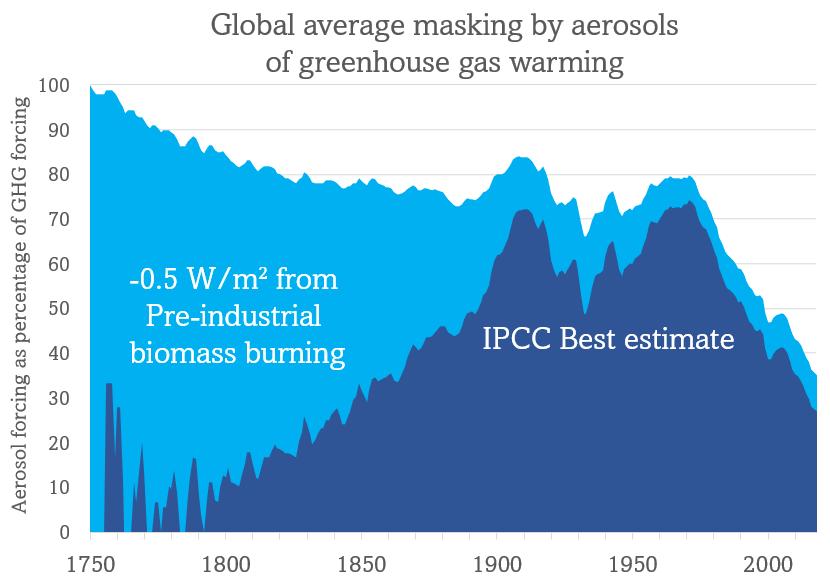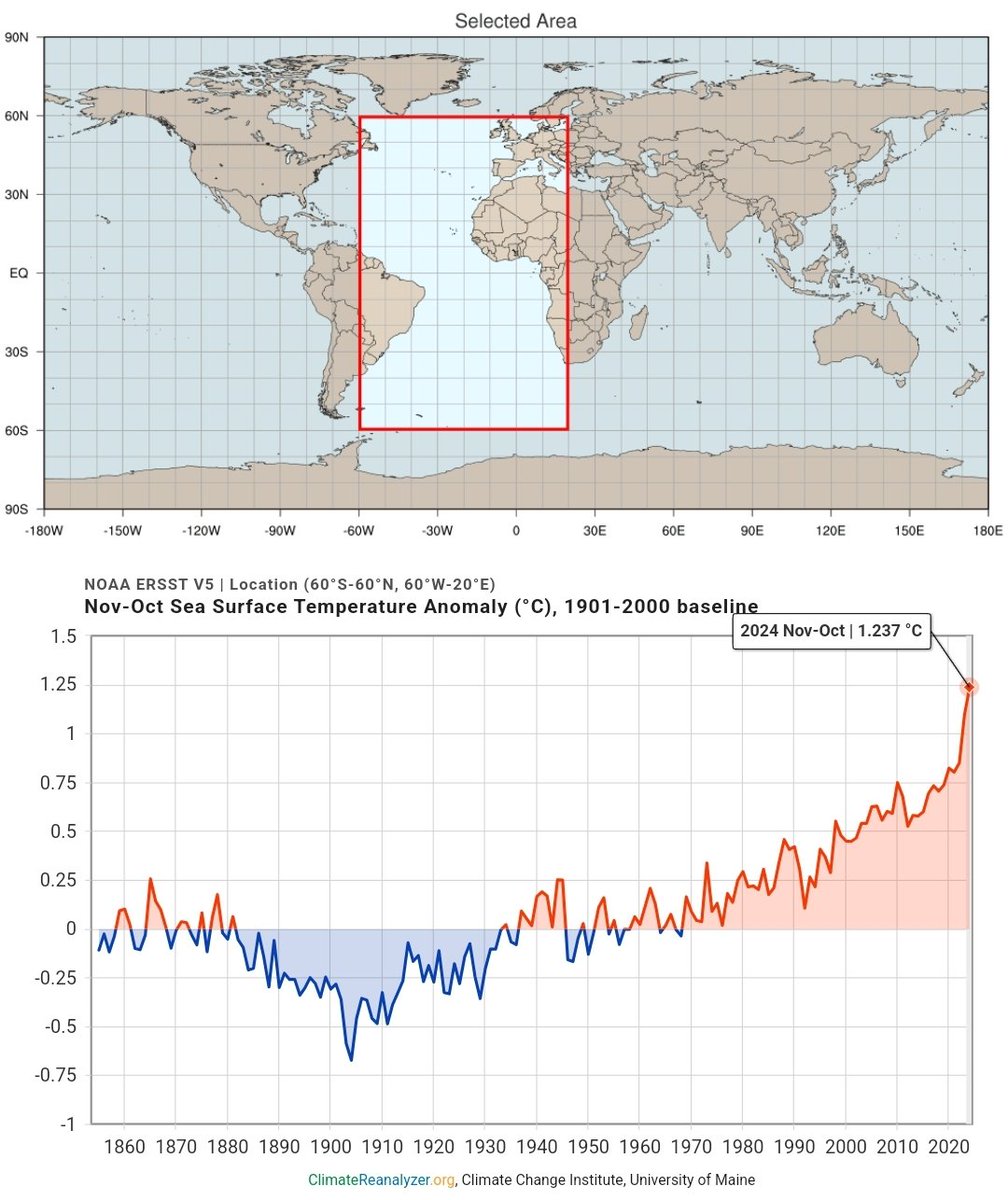🔥 Smoke from our fires kept Earth cool.
🗓️ Potentially for thousands of years!
In Global warming in the pipeline (1), our recent paper lead by the great @DrJamesEHansen, we presented this theory.
This might help answer the question of why the planet didn't warm (or even cooled down!), while greenhouse gas concentrations increased.
This is one of the greatest unanswered questions in (paleo-) climate science, coined the Holocene temperature conundrum.
Climate models are used to reconstruct the climate of the past 12,000 years (known as the Holocene).
These models use knowledge about changes in the orbit of our planet around the sun (Milankovitch cycles).
The changing orbit changed how much sun was shining on the Northern and Southern Hemispheres over time:
Erb et al.(2), their Figure 3 "Modeled hemispheric insolation and temperature in different seasons. Insolation (W/m², dashed) and temperature (°C, solid) from the HadCM3 deglacial simulation, averaged for the annual mean (black), June–August (red), and December–February (blue) for the (a) Northern Hemisphere and (b) Southern Hemisphere."
Even while incoming sunlight (insolation) over the Northern Hemisphere decreased during summer, the models (2) still show warming during June, July, August (JJA).
This is because of increased greenhouse gas concentrations, which are obtained from ice core data and included in the models.
Ice cores from Antarctica show that captured air bubbles over the past thousand of years saw increasing concentrations of both CO2 and methane (CH4):
Ruddiman et al. (3) showed this didn't happen during other previous warm periods (interglacials).
They state that "Paleoecology and archaeology show that early farmers emitted large amounts of CO2 and CH4".
Through deforestation and land use changes (including methane emitting rice production), the amount of greenhouse gases in the atmosphere increased.
With the increasing greenhouse gases, the models show increasing temperatures over the past 6,000 years.
But this is not what temperature reconstructions for the Northern Hemisphere show:
Global temperature trend from 6000 years ago to before the industrial revolution in °C/1000 years.
Erb et al. (2), Figure 6.
So far, there was no satisfactory answer to what caused this Holocene temperature conundrum.
Our theory is that the greenhouse gas warming was masked by smoke from humanity spreading around the planet and setting fire to biomass 🔥🌳🔥🌲 and turning forests into grasslands (land use change).
The smoke consists out of aerosols, which absorb and reflect sunlight and increase cloud cover (by acting as cloud condensations nuclei), which also increases sunlight reflection.
The dimming effect of so called aerosol-cloud interactions is the largest uncertainty in climate science overall.
With relation to paleoclimate, anthropogenic aerosols have barely been considered!
In more recent history, the best estimate of the IPCC is that aerosols masked about 55% of the greenhouse gas forcing over the past 100 years.
Taking into account an estimated pre-industrial aerosol masking ('cooling') of about -0.5 W/m² shows that effectively reducing air-pollution would cause even more warming than previously thought:
Adapted from figure 17b of (1).
As with any (new) scientific theory, this will require further judgement, tests and insights from peers.
We look forward to the perspectives of paleoecologists, archaeologists, anthropoligists, geologists and modellers.
----
Thank you for finishing this Long Read!
I'm planning to add further evidence for and against this theory in this thread in the future.
References:
(1) @DrJamesEHansen, @MakikoSato6, @LeonSimons8 et al. (2023)
Global warming in the pipeline
(2) @MichaelPErb et al. (2022)
Reconstructing Holocene temperatures in time and space using paleoclimate data assimilation
(3) Ruddiman et al. (2015)
Late Holocene climate: Natural or anthropogenic?




🗓️ Potentially for thousands of years!
In Global warming in the pipeline (1), our recent paper lead by the great @DrJamesEHansen, we presented this theory.
This might help answer the question of why the planet didn't warm (or even cooled down!), while greenhouse gas concentrations increased.
This is one of the greatest unanswered questions in (paleo-) climate science, coined the Holocene temperature conundrum.
Climate models are used to reconstruct the climate of the past 12,000 years (known as the Holocene).
These models use knowledge about changes in the orbit of our planet around the sun (Milankovitch cycles).
The changing orbit changed how much sun was shining on the Northern and Southern Hemispheres over time:
Erb et al.(2), their Figure 3 "Modeled hemispheric insolation and temperature in different seasons. Insolation (W/m², dashed) and temperature (°C, solid) from the HadCM3 deglacial simulation, averaged for the annual mean (black), June–August (red), and December–February (blue) for the (a) Northern Hemisphere and (b) Southern Hemisphere."
Even while incoming sunlight (insolation) over the Northern Hemisphere decreased during summer, the models (2) still show warming during June, July, August (JJA).
This is because of increased greenhouse gas concentrations, which are obtained from ice core data and included in the models.
Ice cores from Antarctica show that captured air bubbles over the past thousand of years saw increasing concentrations of both CO2 and methane (CH4):
Ruddiman et al. (3) showed this didn't happen during other previous warm periods (interglacials).
They state that "Paleoecology and archaeology show that early farmers emitted large amounts of CO2 and CH4".
Through deforestation and land use changes (including methane emitting rice production), the amount of greenhouse gases in the atmosphere increased.
With the increasing greenhouse gases, the models show increasing temperatures over the past 6,000 years.
But this is not what temperature reconstructions for the Northern Hemisphere show:
Global temperature trend from 6000 years ago to before the industrial revolution in °C/1000 years.
Erb et al. (2), Figure 6.
So far, there was no satisfactory answer to what caused this Holocene temperature conundrum.
Our theory is that the greenhouse gas warming was masked by smoke from humanity spreading around the planet and setting fire to biomass 🔥🌳🔥🌲 and turning forests into grasslands (land use change).
The smoke consists out of aerosols, which absorb and reflect sunlight and increase cloud cover (by acting as cloud condensations nuclei), which also increases sunlight reflection.
The dimming effect of so called aerosol-cloud interactions is the largest uncertainty in climate science overall.
With relation to paleoclimate, anthropogenic aerosols have barely been considered!
In more recent history, the best estimate of the IPCC is that aerosols masked about 55% of the greenhouse gas forcing over the past 100 years.
Taking into account an estimated pre-industrial aerosol masking ('cooling') of about -0.5 W/m² shows that effectively reducing air-pollution would cause even more warming than previously thought:
Adapted from figure 17b of (1).
As with any (new) scientific theory, this will require further judgement, tests and insights from peers.
We look forward to the perspectives of paleoecologists, archaeologists, anthropoligists, geologists and modellers.
----
Thank you for finishing this Long Read!
I'm planning to add further evidence for and against this theory in this thread in the future.
References:
(1) @DrJamesEHansen, @MakikoSato6, @LeonSimons8 et al. (2023)
Global warming in the pipeline
(2) @MichaelPErb et al. (2022)
Reconstructing Holocene temperatures in time and space using paleoclimate data assimilation
(3) Ruddiman et al. (2015)
Late Holocene climate: Natural or anthropogenic?




• • •
Missing some Tweet in this thread? You can try to
force a refresh






















